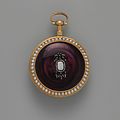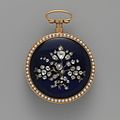Jewelry watch

The term Schmuckuhr (formerly Phantasieuhr ) is a colloquial , often times specifically the used collective term for watches whose design significantly by a fashion is affected. The time display, as the actual main function of the watch, takes a back seat to its importance as a fashion accessory in jewelry watches .
Nowadays the term is used slightly derogatory, as it is often used for low-quality fashion watches from mass production . But especially in the luxury watch sector there is a large number of high-quality jewelry watches, for example the ladies' model "Happy Diamonds" from the watch manufacturer Chopard .
Historical
In the 17th and 18th centuries, the first artfully designed jewelry watches emerged from the collaboration of watchmakers and the arts and crafts. High-quality objects of daily life, such as perfume bottles, jars, salt and vinegar vessels, cases, walking sticks and the like were provided with small clockworks and richly decorated. In this way, the desire of wealthy customers for extravagance and emphasis on social position could be met.
A center of jewelry watch production in the late 18th and early 19th centuries was Geneva , which became prosperous in the Age of Enlightenment . It enjoyed an international reputation for the manufacture of luxury watches and excellent enamel painting . Still under the influence of Napoleonic fashion, the masters of the “Geneva School” returning from European courts combined both trades into artistic and technical perfection. Clockworks were used in silver rabbits, in fantasy birds and shells cut from rock crystal. Casings were engine-turned and chiseled or set with pearls.
Many pocket watches were produced for the oriental market, especially for China, India, Persia and Turkey. Here, too, the direct influence of the respective country-specific fashions on the design of the jewelry watches is evident. “Chinese” clocks were generally round, large, and heavy. They were often equipped with chimes and bells. The enamel painting showed western scenes, not Chinese ones. Clocks for the Turkish market, on the other hand, were smaller, decorated with garlands and Turkish dials, while the enamel was painted with mosques and minarets.
During the Neo-Gothic and Neo-Renaissance periods of the late 19th century, jewelry watches lost their design quality and importance.
gallery
Pocket watch , Antwerp, around 1600, gold, precious stones, collection of the German Clock Museum , Furtwangen .
Carriage clock, ball clock, South Germany, 17th century, Germanisches Nationalmuseum collection
Pendant clock and clock key at a Châtelaine, France, 18th century, Walters Art Museum collection
Jewelery watch, gold, pearl enamel, silver, diamonds and opal, around 1790, Metropolitan Museum of Art
Chain watch , Switzerland, around 1820, silver, gold, enamel, glass, diamonds, ivory, Walters Art Museum collection
Neck or pendant watch, beetle-shaped, Switzerland, 1850–1900, gold, diamonds, enamel, Museo Poldi Pezzoli collection , Milan .
literature
- George Frederick Kunz : Early Artistic Watches. In: The monthly Illustrator. Volume 11, 1895, pp. 313-320.
- Johann Willsberger : Magical cases of the time [...] . Econ, Düsseldorf 1974, ISBN 3-430-19665-5 .
- Reinhard Meis : The old clock , vol. 2. Klinkhardt & Biermann, Braunschweig 1978. pp. 261–263
- Osvaldo Patrizzi, Fabien X. Sturm: Jewelery watches 1790-1850 [...] . Callwey, Munich 1981, ISBN 3-7667-0563-6 .
- Hans Nadelhoffer: Cartier - King of the jewelers, jeweler of kings. Herrsching 1984.
- Hans Nadelhoffer: Cartier - The watch as a jewel. In: Old clocks. No. 2, 1985, pp. 9-26.
- Antiquorum: The Art of Breguet. An Important Collection of 204 Watches, Clocks and Wristwatches. [...] . Geneva (CH) 1991.
- Jan H. Leopold, Clare Vincent: An Extravagant Jewel - The George Watch. In: Metropolitan Museum Journal. Volume 35, 2000, pp. 7 and 137-149.
Individual evidence
- ↑ a b Osvaldo Patrizzi, Fabien X. Sturm: Jewelery watches 1790-1850 . Callwey, Munich 1981, ISBN 3-7667-0563-6









